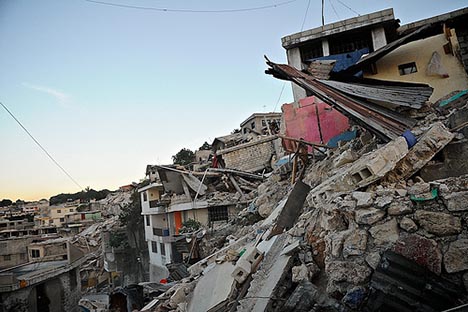


interest in history. They concluded that understanding of the past maintained family and community connections and addressed questions about relationships, identity, immortality, and agency. Lacey noted that physical representations of Haiti’s culture and history have allowed Haitians to endure through “political trauma, staggering violence and a string of natural disasters.” An artist’s reaction to the destruction of a painting encapsulates the depth of artifacts’ psychological hold. He told Lacey, “That’s about all I had left.” However, accompanying dismay over lost artifacts is recognition of the value of surviving ones and a mobilization to safeguard them. Through interviews with students, artists, aid workers, and entrepreneurs Lacey illustrates Haitian appreciation for archival materials’ importance in rebuilding the first independent black republic. He quoted sculptor Patrick Vilaire, part of a community group dedicated to securing artifacts from looters and unsound buildings. Vilaire explained his involvement as motivated by the fact that without memory of the past the survivors “can’t continue living.” Even in the midst of death and destruction, physical manifestations of history and the repositories that preserve them are vital for the present and future.
The second thread of Lacey’s article demonstrates the potential danger of consolidating all of a nation’s or culture’s archival materials in a single repository. In Haiti the National Museum and the National Archives suffered only minor structural damage, and although no comprehensive assessment of their contents has been done, UNESCO representatives believe their collections probably survived. However, had those two buildings been destroyed, their contents and Haiti’s past also would have been destroyed. Vilaire’s story suggests that Haitian society recognized the inherent dangers of consolidation, even if for a different reason, and indemnified against them. Among the priorities of Vilaire’s group was the preservation of two private collections of political and economic texts. Lacey observed, “…after so many years of government dysfunction, private groups and individuals had become some of the most important protectors of the country's treasures.” Concerns like the ones that motivated the creation of presidential libraries in the United States rightly enumerate the potential dangers to archival materials dispersed among diversified hands. The consequences of unregulated custodianship - loss, intentional destruction, and irreversible damage due to negligent care - can erase broad swaths of history, but consolidation possesses inherent dangers as well. Instead of portions of history, consolidation leaves history’s entirety exposed to vagaries of political will and/or catastrophe.
Marc Lacey’s report of the literal monumental destruction of Haiti demonstrates the power of history, the far-reaching consequences of its loss, and the need for active, dynamic preservation of its physical manifestations. It also questions the wisdom of depositing all of history in a few select physical repositories. The earthquake’s devastation serves as a reminder that cataclysm can frustrate even the best realized ambitions. The political will motivated by preservation instincts and manifested in the creation and maintenance of national archives needs to be extended to include support for secondary, and even unofficial, repositories.
References
- Lacey, M. (2010, January 24). Cultural Riches Turn to Rubble In Haiti Quake. New York Times, The (NY) Late Edition - Final ed., 1. Retrieved January, 27 2010 from NewsBank on-line database (Access World News)
- Posner, Ernst (1984) Some Aspects of Archival Development Since the French Revolution. A Modern Archives Reader. Washington DC: National Archives and Record Service. pp. 3-14. (Reprinted from The American Archivist, 3, July 1940)
- Reylea, H.C. (2008). Presidential Libraries: The Federal System and Related Legislation. CRS Report for Congress. Washington, DC: The Library of Congress.
- Rosenzweig, Roy. & Thelen, David. (1998) The Presence of the Past. New York: Columbia University Press. pp. 15-36.
© 2010 Robert McKercher. All rights reserved.


Photo Marco Dormino/ The United Nations United Nations Development Programme
Digging Out:
The Power of the Past in the Face of Tragedy
Given the life and death struggles of Haitians in the aftermath of January 2010’s devastating earthquake, apathy for the welfare of archival materials would be understandable and forgivable. But according to an article by Marc Lacey (2010) in The New York Times, the opposite is true. Even as homeless millions depend on aid workers for food, water, and medical treatment some Haitians have begun assessing the damage to the physical manifestations of their history, and they are acting to mitigate further damage. Lacey’s article illustrates the visceral appeal and the universal reach of archival materials’ relevance. Also his report on the disaster’s aftermath suggests that the French ideal of a single consolidated repository for a culture’s artifacts, as described by Ernst Posner in 1940, may be not only impossible but unwise.
Lacey’s description of historical artifacts’ role in sustaining Haiti’s cultural pride through hardship echoes the findings of Roy Rosenzwieg's and David Thelen's 1998 survey of Americans’